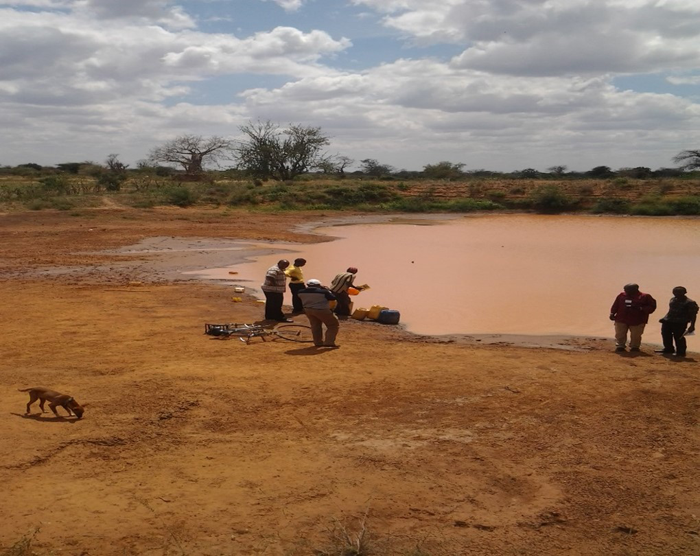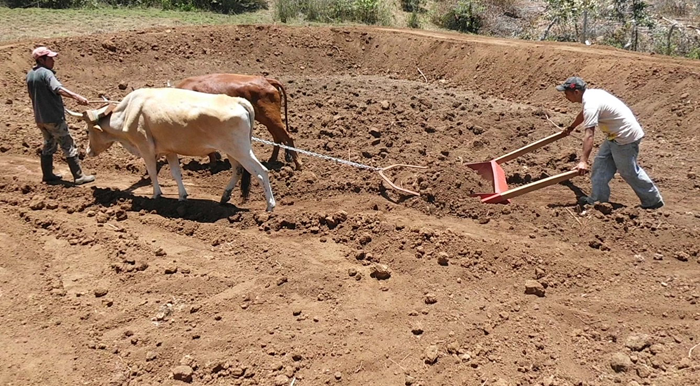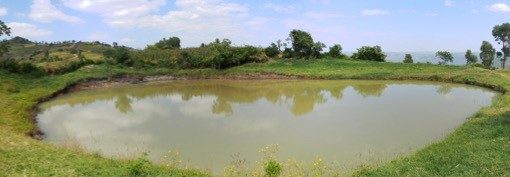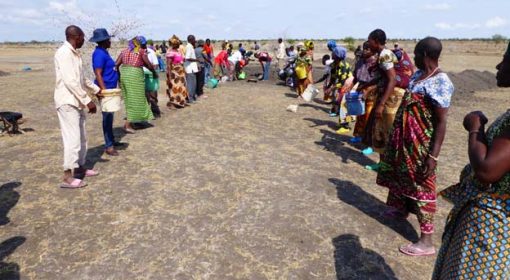By Frank van Steenbergen
July 16, 2015

Picture 1: Pond, Yimwaar, Kenya
Are things getting better in the world? You wonder when you are in Yimwaar in Ngulu near Kibwesi in Makueni in Kenya. Here, people drink water collected in a pond and the water is an orange-coloured turbid. The area of the pond is unprotected. Dogs stray in and out and drink from the pond, so does livestock and then people collect water on bikes and take it the turbid water to their home steads. This is 2015, the year in which we were supposed to have moved ahead a lot and to have the Millenium Development Goals achieved.
It is water for the poorest. The pond was made by local labour in the past under a cash for work program. It is 40 meter by 40 meter, collecting water from many different little streams running in the rainy period over all type of surfaces and then ending up in the pond.
Pollution is the word as is neglect. Asking how the pond is maintained, the answer is ‘it is not, the users wait till the next non government organizations comes around to pay people to silt out the pond. There is a suffocating feeling of helplessness around Yimwaar that is as bad as the polluted water.
It is not that things could not be better. There are thousands of places like Yimwaar where there is no alternative for domestic water but to collect run-off water, yet even then things do not have to be as bad as they are.
First of all there could be more regular maintenance after each season, cleaning out the sediment. There are several ways to do this. One simple system is to divide the area in squares and have all families that use the water clean out their square with accumulated sediment lest they not have access to the water the next season. Then an important innovation could be the use of scoops that help clean out the pond, as being applied in Central America for instance

Picture 2: Developing a pond with a ‘road scoop’ in Honduras (Picture: Roque Almendares IDE Honduras)
The second change would be to have a proper live fence or trench around the pond to make sure that animals do not wonder in. And a guard to ensure that the fence is maintained and the pond is protected.
The third simple and essential change is the use of a slow sand filter on the pond and the use of a hand pump to lift water from the sand filter. The way the ingenious slow sand filters work, is that they create a wet environment attracting bacteria that remove almost all pathogens from the water. As long as they stay wet they are highly effective and hence very much suited for drinking water ponds. Elsewhere – on the drinking water ponds in Sudan for instance – they are common, but in Makueni they are exceptional.

Picture 3: Sand filter
All this is bewildering. There is no lack of development initiatives, enter any small town in Makueni and there is a forest of sign posts of good causes and well-do-ers. Yet there is no sand filter and no basic maintenance of the drinking water ponds. All this is shocking, and one wonders whether the sign-posts and the basic neglect aka ‘dependency syndrome’ go together.
There is a need to do much more on water ponds. They are so basic and essential and yet they are also so much forgotten. There is an urgent need to innovate – better liners to prevent seepage, standard use of water treatment such as sand filters and introducing tools such as scoops to develop and maintain such ponds.
It would help a lot to bring us to 2015 – the year of reckoning on the MDGs.


